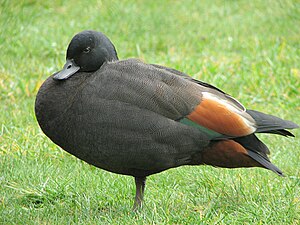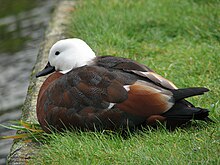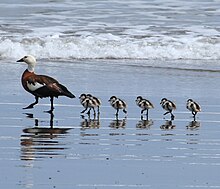Paradise Kasarka
| Paradise Kasarka | ||||||||||||
|---|---|---|---|---|---|---|---|---|---|---|---|---|

Paradise Kasarkas ( Tadorna variegata ), Ganter |
||||||||||||
| Systematics | ||||||||||||
|
||||||||||||
| Scientific name | ||||||||||||
| Tadorna variegata | ||||||||||||
| ( Gmelin , 1789) |
The Paradise Kasarka ( Tadorna variegata ) is a duck bird that is native to New Zealand and belongs to the demi-geese . The species has an unusually pronounced difference in the plumage of the two sexes for the genus Kasarkas .
In New Zealand, the Paradise Kasarka is one of the few native species that benefit from human changes in New Zealand's vegetation. As a crop follower, it can be observed on pastures and in water retention basins. It is correspondingly frequent and can be hunted. Every year around 100,000 Paradise Casarcas are shot in New Zealand. However, hunting is now more strictly regulated, as there has been a significant population decline in some regions due to hunting.
Appearance
Paradise Kasarkas are a small type of Kasarka. They show the goose-like habit that is characteristic of this genus. Their body length is between 63 and 71 centimeters. They weigh between 1.5 and 2 kilograms. The species shows a conspicuous sexual dimorphism. In a magnificent dress the gander has a black-green head and neck. The rest of the body is darkly feathered. The under tail cover is of a strong clay brown. The beak is black, short and slightly arched in relation to the size of the head. The legs and feet are dark gray. The eyes are black.
The female has a white head and neck in her splendid dress. The back is dark gray. The flanks and the under tail cover are bright chestnut red. Legs, feet, beak, and eye color match those of the male. Fledglings resemble adult males. The coat plumage is washed over dark brown and black-gray. The wings are colored like the adult birds, but the large blankets are gray and not white. The head is blackish-gray, the base of the beak and the area around the eyes are lightened. Young females are slightly smaller than young males and have a white beak base. Their backs and flanks are also a bit browner. The white head characteristic of the females is shown by young female paradise kasarcas from the 2nd year of dress.
Adult females moult between January and March and thus towards the end of the breeding season. They start changing their small plumage when the young birds are around 40 days old. The swingarm spring is released a little later. You will then be unable to fly for a period of 28 to 42 days.
Possible confusion with other species
There is hardly any possibility of confusion with any other species. In the female, the white head and neck in particular are conspicuous and characteristic in all seasons. The males and juveniles, on the other hand, with their dark head and neck, can be confused with the Australian Kasarka , which is similar to the Paradise Kasarka in terms of body size, shape and posture. The Paradise Kasarka, however, lacks the white collar and, unlike the Australian Kasarka, has a solid, dark underside.
The greatest possibility of confusion is between the female of the Australian Kasarkas and young females of the Paradise Kasarkas, which are just changing their body plumage to the adult female. In these, the white head and neck are not yet very pronounced. Young female Paradise Kasarkas can also be distinguished from the Australian Kasarkas by the lack of a white collar and the dark and non-chestnut-colored tail covers.
Distribution, habitat and existence
Paradise kasarcas are an endemic species of New Zealand. Irregulars occur in an easterly direction as far as the Chatham Islands and occasionally reach Lord Howe Island in a northwesterly direction . Before the colonization of New Zealand, the Paradise Kasarka was limited to the southern island and only rarely occurred north of 39 ° S. At that time, paradise kasarkas only occurred on swamp areas that were overgrown with low tufts of grass. Presumably the species was relatively rare, as such habitat was not often found.
Humans' conversion of forest to pastureland has allowed the species to expand its habitat and is now common across New Zealand. As a species that uses pastureland for food, it is now common on all agricultural land. While it used to be dependent on old trees because it needed breeding caves for reproduction, its most common nesting sites today are the burned-out stumps of the tree trunks remaining after slash and burn. In New Zealand, they can also be found in waters that are in an urban setting. Although the Paradise Kasarka is hunted, the population is increasing. In 2001 the population was more than 300,000 individuals.
Small bodies of water and swamps are sufficient as breeding grounds for the Paradise Kasarka, provided that there is sufficient pastureland. A small part of the population also inhabits estuaries and flat coastal regions. Paradise Kasarkas also breed in the New Zealand Alpine region on plateau plains with slowly flowing waters. Paradise kasarcas are predominantly resident birds, the moulting sites are also not far from the breeding grounds.
Way of life
Paradise kasarcas mainly eat vegetable food, only the young live mainly on insects during their first five weeks. Most of the food is found by grazing on pastureland or mown farmland. They also pick up insects and worms when they find them. Downy chicks start grazing around a week old.
During the breeding season, two forms of coexistence can be distinguished: pairs defend breeding grounds and larger groups of non-breeding Paradise Casarcas can be found in certain places near water and good foraging grounds. These flocks consist mainly of young birds from the previous breeding period. In the flocks, however, there are also some two-year-olds as well as unmated, sexually mature older birds.
For around two months a year, the pairs leave their breeding grounds and stay together with their offspring and the non-breeding Paradise Casarcas at traditional moulting sites. These are usually large ponds, reservoirs, lakes and rivers. The first individuals arrive at these moulting sites towards the end of December. These are usually paradise kasarcas in the first and second year of life. The breeding pairs follow a little later and are accompanied by their offspring this year. During the moult, the Paradise Casarcas are unable to fly for about four weeks. The moulting sites are left in the period from March to April.
Breeding biology
Paradise Kasarkas are sexually mature in their second year, but only about fifty percent of the females of this age group breed in their second year of life. This has to do with the fact that the birds must have been mated and occupied a breeding area in the year before the first attempt at breeding. The proportion of two-year-old kasarkas who successfully start hatching in their second year of life varies accordingly every year: in some years, one-year-old kasarkas are not able to find suitable territories. The number of breeding two-year-olds is correspondingly lower in the next year.
Paradise Casarcas form couples whose relationship lasts for a lifetime. The Paradise Kasarkas choose their breeding ground two months before they lay eggs. It is vigorously defended by both sexes. From August to October 6–12 white eggs are laid in a nest that can be sheltered in tree hollows, in rabbit burrows, under the roots of fallen trees or in crevices in the rock. It is padded with grass and feathers to protect the eggs. Only the female breeds. The male stays near the nest and is later involved in raising the young. The loss of chicks is relatively small. On average, six young birds fledge per clutch. Both parent birds guard the young birds and try to seduce predators. When threatened, the young gather in a dense group in the middle of the nearest pond. They dive when they feel threatened, or try to hide in the floating vegetation. The main cause of death of young Paradise Kasarcas is unfavorable weather conditions. In addition, feral domestic cats chase after them. In addition, some of the hatched downy chicks fail to leave the nesting chamber.
Attitude in Europe
The first Paradise Casarcas in Europe were shown at London Zoo from 1863. The first Paradise Kasarkas in Germany were shown at the Berlin Zoo from 1869. In contrast to the Australian Kasarka , which first came to Europe at the same time and was only bred in 1939, the offspring in both zoos was already in the second year of keeping. Since then, paradise kasarcas have been kept regularly in zoos and are occasionally kept by private individuals as water fowl. They have proven to be less sensitive to the cold and tolerate smaller duck species. However, they behave aggressively towards other geese and swans.
supporting documents
literature
- PJ Higgins (Eds.): Handbook of Australian, New Zealand & Antarctic Bird , Volume 1, Ratites to Ducks, Oxford University Press, Oxford 1990, ISBN 0195530683
- Janet Kear (Ed.): Ducks, Geese and Swans. Oxford University Press, 2005, ISBN 0-19-854645-9 .
- Hartmut Kolbe; Die Entenvögel der Welt , Ulmer Verlag 1999, ISBN 3-8001-7442-1
Web links
- Tadorna variegata in the endangered Red List species the IUCN 2008. Posted by: BirdLife International, 2008. Accessed January 31 of 2009.
- Videos, photos and sound recordings of Tadorna variegata in the Internet Bird Collection



